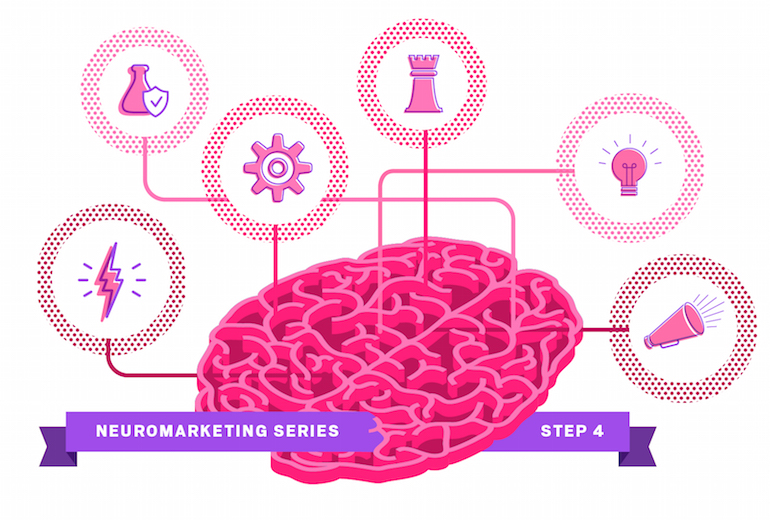Brains love a good story. Stories that grab and hold our attention make us happy, especially stories with just the right amount of description, where you can identify with the character and see yourself going along on a journey with them. We are hardwired to be able to experience other’s emotions.
Strong marketing stories will work they same way: they’ll draw decision makers in to your content, because they see themselves reflected in the problems you are solving. You need your products and services to come to life and capture the impact that building a relationship with your company can have.
Now is the time to take your target audience insights and mix them with neuroscience to create a combination that will engage the brain. Engaging the brain helps you stand out from the crowd, and helps the decision makers remember you and your message. It’s the power of neuromarketing.
So far in this neuromarketing series we have worked with you to build your target audience insights, create a client persona (a representation of the decision maker you are targeting) and put your collected insights to work within a neuroscience-enhanced marketing strategy. You’ve also been able to take an even deeper dive into your data using the Persona Builder Guide.
Based on what you have learned so far, you know how to create online content that will help you capture the eye of the decision makers as they scan and search for solutions. The next step is to take the attention you’ve captured and keep them engaged with stories
In our last post of the series, we want to show you how to take all the research and data you have collected and combine them with neuroscience to create marketing materials that will captivate your potential clients, your strategic partners and your potential investors.
Each of these groups will have different needs and emotions that would drive them to build a business relationship with you:
Potential clients are frustrated and looking for a solution to a problem you can solve.
Strategic partners are cautious and searching for a mutually beneficial synergistic relationship.
Investors are savvy and hunting for the next big thing.
A single story is not going to connect with each of them. Instead, grab and engage the attention of the brain by creating marketing materials, like a short presentation, that tells a story – using their keywords, key phrases, visuals and emotions – all customized to each of these groups.
Many science and research based companies struggle to create and share great stories. The industry tends to rely on data and logic as the point of persuasion; however, neuroscience studies have consistently shown that decision-making is an emotional process. Effective storytelling is also rooted in being emotional. The solution? Take your decision maker on a journey from life before your company‘s solution, to what life can be like once they have your products and services.
Here are some storytelling best practices and how to target them towards each one of these key groups.
Visuals to Capture Your Target Audience
Visuals make or break a presentation, an article or an ebook in an instant, because a significant part of our brains focus on processing visuals. Our brains are bombarded by millions of pieces of information all day, every day. Thankfully, we are not consciously aware of this bombardment because there are parts of our brains that process and flag anything we need to be consciously aware of.
The marketing hack? You want your visuals to be flagged by the brain of your decision maker. Something out of the ordinary, something the audience wouldn’t be expecting – that element of surprise in a visual gives you the opening you need to keep the audience engaged. For example, when you create a slide deck for an investor pitch, your presentation cannot look like the dozens they have seen before. A traditional slide with company branding and a few bullet points and a graph is not creative or unexpected.
Conversely, if you launch with text only, then listeners go into autopilot mode. So don’t let them – keep your audience with you from the start, and hold them until the end. The good news is we remember things we have seen better than any other form of memory recall. The technical term for this is pictorial superiority effect. It is why flowcharts were easier to study in school than a page of written text. It is also why we remember logos and branding colors better than we remember the marketing ad copy.
In every day life we tend to see objects as whole before seeing the individual parts. This visual hierarchy comes down to the order in which your brain is processing the visuals on a page, within a blog post or on a slide. Brains are therefore drawn to new perspectives, such as groupings and extreme close-ups of everyday objects. This means:
• A human face will rank over a landscape image
• Something colourful will rank over something subdued
• A large visual will rank over a small visual
Consider the two images below. Which one is more appealing? They’re of the same item, but the close up captures the attention of the eye because it offers a new and creative perspective to a known object.
Or in the below, which grabs you more? Both are colorful, but the face, combined with an interesting perspective, draws you in.
You need to consider not only the visuals you use, but how they tie in with your business objectives. Use the tips above and other visual hierarchy best practices to plan out your visuals and draw the eye of your audience where you want it to go. For more specifics on creating visually engaging slide presentations, watch this video: How to Avoid Death by PowerPoint.
Emotionally Engage Your Target Audience
Emotions are a great tool to increase the impact of your content. From neuroscience research we know that the neuronal pathways traveling from the mid brain, the emotion centre, to the new brain, the part of your brain you are consciously aware of, are dense and strong. The mid brain is influencing decision making with minimal to zero input from the new brain.
The idea that decision-making is controlled by parts of the brain that aren’t consciously controlled might make you uncomfortable or even skeptical. We like to assume we are logical beings; that we can step away from our emotions and make a decision based on knowledge.
But in fact, by the time you’re consciously processing your emotion, the mid brain has already done its work. The roots of your decision have already taken hold. Our brain physiology makes us emotional creatures, so instead of fighting it, use emotion strategically in your marketing. Here are a few key reminders of what emotion impacts:
• What visitors to your website and clients remember about your company
• How they will feel when they see your videos and the visuals you share
• Whether recipients will open your email based on what your email subject line says to them
Emotions can be triggered by your brand, right down to the selected colors and font. How do you insert the emotion into your content? You need to define, determine and design, some of which we’ve tackled in earlier parts of this series.
You need to DEFINE with whom you’re trying to connect with – which one of your groups are you creating this particular content for? What pain points are driving them to take action?
Then you need to DETERMINE what their pains and goals are. What are the keywords and key phrases you uncovered during your research and interviews?
Use the insights you gained when you followed them through their story: insights on their needs, their searches, their decisions and their choices. Each one of those points along their journey has emotions associated with it.
Finally you need to DESIGN your content specifically to them, echoing their problems, pains, and other emotions, in order to showcase how your unique products and services can have a positive impact. Use the keywords and key phrases in the titles, email subject lines, and images you’re creating. Visuals are a great foundation for layering key words to highlight the emotion you are targeting and to draw the eye of your audience toward your call to action.
Launch the content piece by focusing on their problem, pain or need and show them you “get it” – that you understand and empathize with them.
The Decision Maker’s Journey
In a previous post, we discussed how decision maker interviews provide a wealth of information. These interviews are short 15-20 minute calls or face-to-face meetings that give the decision maker a chance to tell their story – their journey to finding a solution to their problem (which often shares a common path with other groups):
The NEED triggered by their pains or frustrations,
The SEARCH as they assessed products and/or services,
The DECISION making process once the search was completed and
The CHOICE made in the end.
Keep in mind that your target audience’s search behavior is often the most overlooked part of the emotional cycle your decision maker is going through. At this point they are not committed to you; they are simply trying to find solutions and answers.
How do you connect with a searching decision maker when you don’t even know they are out there?
Your interview insights showed you how. They told you where they were searching, what they were searching for, what was relevant to them and what was irrelevant to them. Most importantly, they shared with you what it was they could not find. Take this data and create content that speaks directly to this point in their journey. A few examples of what to create could be:
• the ideal compare and contrast FAQ section
• short end-user videos focused on what you heard from their search
• an infographic that tells them the most important product details, all in one location
Creating and sharing the content that speaks directly to your decision makers gets you on to the short list of companies that they will explore in-depth.
Stories for Your Target Audience
Storytelling is the best way to bring visuals and emotions together. When you start to tell a story that directly connects with a decision maker, there are layers of brain responses triggered in them.
They identify with the “self” within the story – and they want to know how the story plays out. They are intrigued by the contrast between their current state of mind and the environment being created within your story. The emotional part of their brain is drawn through the use of sensory and emotional text and visuals.
Meanwhile, the part of the brain the decision maker is consciously controlling is collecting and retaining any facts and data to further support the “you understand me” feeling you’ve already created.
The character in your story understands their pains and goals and emotions. The character in your story uses the same keywords and key phrases as them. These effective stories will make the reader feel like they have stepped into the text or into the video.
Each persona interview you conducted had its own story arc – you learned about their trigger, their journey into solving their pains and problems and their resolution when they reached their goal. Now you need to find the common areas between your expertise and their story and fuse them together into a powerful emotional story that focuses on how you can positively impact them.
Start by taking a look at how you are sharing your own story. Successful companies pair intelligent storytelling along with their logos, company colors and visual styles. They are consistent right down to the fonts used across all platforms and marketing assets.
During the interviews with decision makers, you will likely discover that they are interested in the story behind your company. This is because people like to work with companies that align with their own values and mission. If you take a look at your online presence and marketing materials, what would you learn about your company?
Can a decision maker readily find:
• The story behind the founding of your company?
• Why you love to provide your services and products to your clients?
• Your focus on respect and integrity?
The visual aspect of your brand story influences your decision maker’s perception of you as well. Are you sharing pictures of you and your team volunteering in the community, or are you outdoors or showcasing your collaborative work environment? What do you want them to know, above and beyond your products and services?
At the end of the day, knowing your unique story and solutions is a competitive advantage. Knowing your target audience and having persona insights is a competitive advantage. These are the most important ingredients of a marketing strategy.
In our first blog post of the series we talked about how storytelling is an important marketing skill. Remember the storytelling outlier from the conference: Someone who knows how to draw people in to their stories, in to their presentations and in to their research. These presenters make science, their products and their services come to life. Engaging the brain helps you stand out from the crowd, and helps your decision makers remember you and your message. Now you are the outlier in your industry.
Interested in learning more about putting brain insights to work? Listen to this replay of our neuromarketing webinar for lots of tips and answers to your questions. Download our Persona Builder Guide for the step-by-step instructions on building a neuromarketing strategy.
























